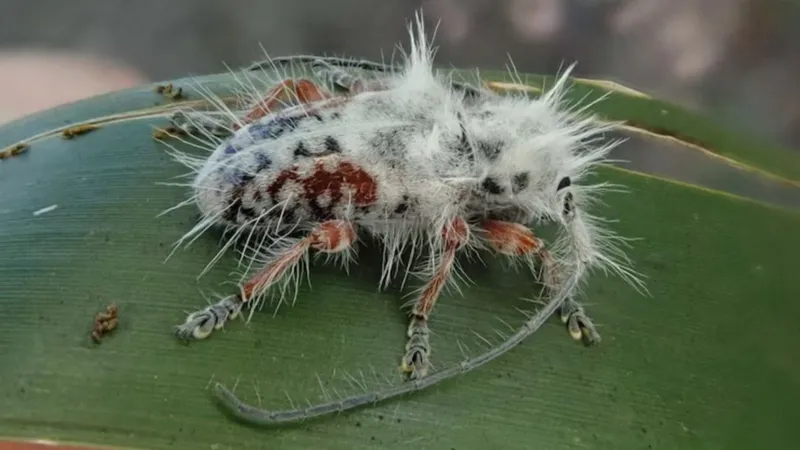Newly discovered Australian beetle almost mistaken for bird poo
What's red, black, and hairy all over? A new species of bug discovered in Australia, dubbed by some as a "punk beetle" for its shaggy white locks.

A Queensland researcher spotted the fluffy specimen by chance while camping and initially mistook it for bird poo.
"It's very unique. There are not many insects out there that have that trait," James Tweed told the BBC.
The national science agency CSIRO has since confirmed it's an entirely new kind of longhorn beetle.
When Mr Tweed first spotted a tiny white object on a leaf in the Gold Coast hinterland in December 2021, he didn't think much of it.
But after the entomologist did a double take, he realised it was in fact an insect unlike any he'd seen before.
"It's about one centimetre long... and covered in long, fluffy white hairs," he said.
"A lot of the hairs stand basically straight upright, and so it gives it a bit of a mohawk type look."
Excited, he photographed and collected the beetle to be studied.
After posting to a Facebook group of insect enthusiasts turned up no answers, Mr Tweed - who is a PhD candidate at the University of Queensland - took the bug to the CSIRO's Australian National Insect Collection (ANIC).
"I worked with a couple of colleagues from the national insect collection, who literally wrote the book on these groups of beetles... they examined tens of thousands of specimens in museums all over Australia and the world, and they've never found it before."
Scientists have previously discovered other insect species with spiky hairs - like hairy caterpillars and a jet black ant with an fiery orange mane, which was also from Queensland - but this bug was different.
"I'm not aware of any [other insects] that have a hairdo like this one does."
In fact, it's so unlike any other species that it was declared an entirely new genus of longhorn beetles by the ANIC, officially called Excastra albopilosa - Excastra meaning "from the camp" in Latin and albopilosa "white and hairy".
The scientists aren't sure exactly why the bug is furry, but they think it has evolved to mimic an insect that's been killed by a fungus, as a way of deterring predators.
"Until someone finds more there's a lot of unanswered questions here."
But Mr Tweed says being able to record even this single beetle is a huge win for science.
"It's hard for us to conserve species if we don't even know that they exist."
"It's great to have this beetle getting so much attention and being a bit of an ambassador for insects and conservation."
-bbc







